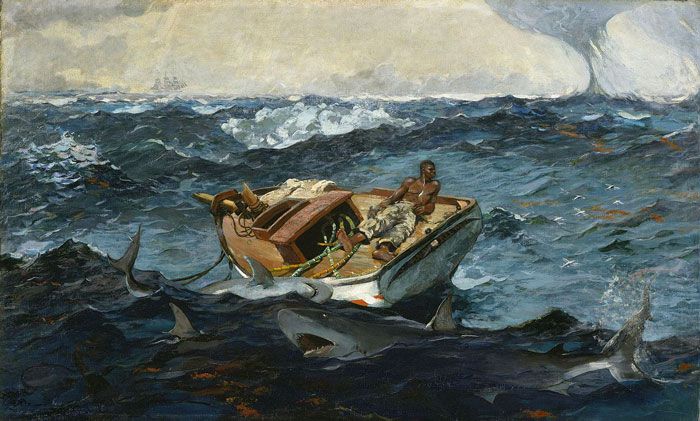
Winslow Homer, come hell or high water
From 11 April to 31 July 2022, the Metropolitan Museum presents “Winslow Homer: Crosscurrents”, an exhibition focusing on the fascination with struggle and conflict present in the work of one of the great figures of American painting.
Image: Winslow Homer, "The Gulf Stream", 1899, oil on canvas, 71.4 x 124.8 cm. Metropolitan Museum of Art, New York.
Born in 1836 and died in 1910, Winslow Homer was the great pictorial chronicler of an America in the throes of change, development and, of course, conflict. A native of Boston, Homer experienced the American Civil War (1861-65) first-hand as an artist under contract to Harper's Weekl, painting his "Sharpshooter" (1863; Portland Museum of Art), which the Metropolitan Museum describes as "his first important oil painting" in the midst of the war. After the war, Homer became interested both in the lives of the soldiers wounded during the war and in the lives of the African-American population, now freed from slavery but far from being accepted by much of the society of the time ("Dressing for the Carnival", 1877, Metropolitan Museum).
But the idea of conflict and struggle is not only present in Homer's work through depictions of conflicts between human beings, but also between man and nature. "The Gulf Stream”, the painting that inspired this exhibition, was painted by Homer after some travels to the Bahamas in the 1880s, during which he became aware of the power of the Gulf Stream. The Metropolitan Museum describes the work masterfully: "A man faces his demise on a dismasted, rudderless fishing boat, sustained by only a few stalks of sugarcane, while threatened by sharks and a distant waterspout. He is oblivious to the schooner on the left horizon, which Homer later added to the composition as a sign of hopeful rescue. Painted shortly after the death of his father, in 1898, the painting has been interpreted as an expression of the artist’s presumed sense of mortality and vulnerability. The Gulf Stream also references some of the complex social and political issues of the era—war, the legacy of slavery, and American imperialism—as well as more universal concerns with the fragility of human life and the dominance of nature." "Winslow Homer: Crosscurrents" includes 88 oils and watercolours, and, according to the Metropolitan Museum, "represents the largest critical overview of Homer’s art and life in more than a quarter of a century." “Winslow Homer is one of the best known and most beloved American artists,” said Max Hollein, the Museum’s Director. “By focusing on the theme of conflict across his art, this exhibition will raise timely questions about his significance and appeal, encouraging a fresh understanding of his deeply thoughtful approach to depicting complex social and political issues of his era—many of which remain pertinent today.”
"Winslow Homer: Crosscurrents" includes 88 oils and watercolours, and, according to the Metropolitan Museum, "represents the largest critical overview of Homer’s art and life in more than a quarter of a century." “Winslow Homer is one of the best known and most beloved American artists,” said Max Hollein, the Museum’s Director. “By focusing on the theme of conflict across his art, this exhibition will raise timely questions about his significance and appeal, encouraging a fresh understanding of his deeply thoughtful approach to depicting complex social and political issues of his era—many of which remain pertinent today.”
Read the full article

